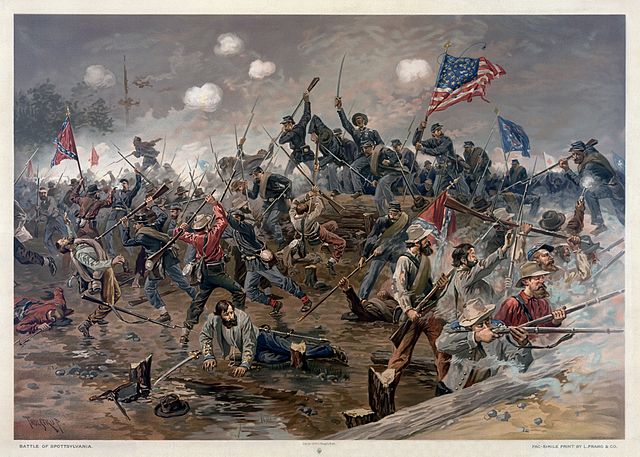Emory Upton was a United States Army general and military strategist, prominent for his role in leading infantry to attack entrenched positions successfully at the Battle of Spotsylvania Court House during the American Civil War, but he also excelled at artillery and cavalry assignments. His work, The Military Policy of the United States, which analyzed American military policies and practices and presented the first systematic examination of the nation's military history, had a tremendous effect on the U.S. Army when it was published posthumously in 1904.
Major General Emory Upton, c. 1865
Emory Upton depicted on the 121st New York Infantry Regiment monument at Gettysburg National Military Park
Battle of Spotsylvania Court House
The Battle of Spotsylvania Court House, sometimes more simply referred to as the Battle of Spotsylvania, was the second major battle in Lt. Gen. Ulysses S. Grant and Maj. Gen. George G. Meade's 1864 Overland Campaign of the American Civil War. Following the bloody but inconclusive Battle of the Wilderness, Grant's army disengaged from Confederate General Robert E. Lee's army and moved to the southeast, attempting to lure Lee into battle under more favorable conditions. Elements of Lee's army beat the Union army to the critical crossroads of the Spotsylvania Court House in Spotsylvania County, Virginia, and began entrenching. Fighting occurred on and off from May 8 through May 21, 1864, as Grant tried various schemes to break the Confederate line. In the end, the battle was tactically inconclusive, but both sides declared victory. The Confederacy declared victory because they were able to hold their defenses. The United States declared victory because the Federal offensive continued and Lee's army suffered losses that could not be replaced. With almost 32,000 casualties on both sides, Spotsylvania was the costliest battle of the campaign.

Battle of Spottsylvania, Thure de Thulstrup
Spotsylvania Courthouse, 1864
Maj. Gen. George G. Meade, Army of the Potomac
Maj. Gen. Winfield S. Hancock, II Corps






